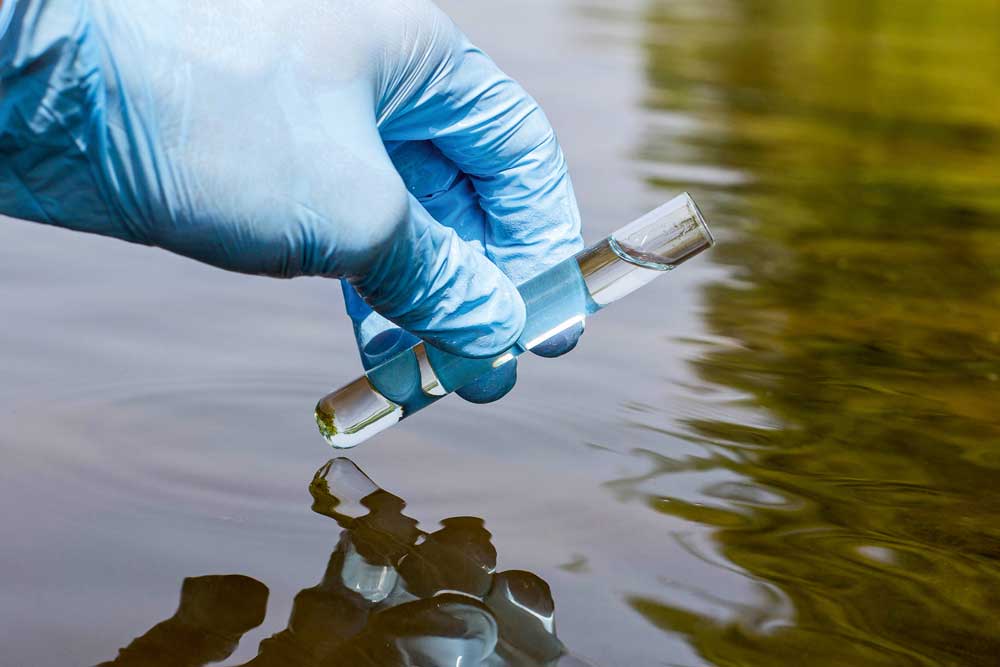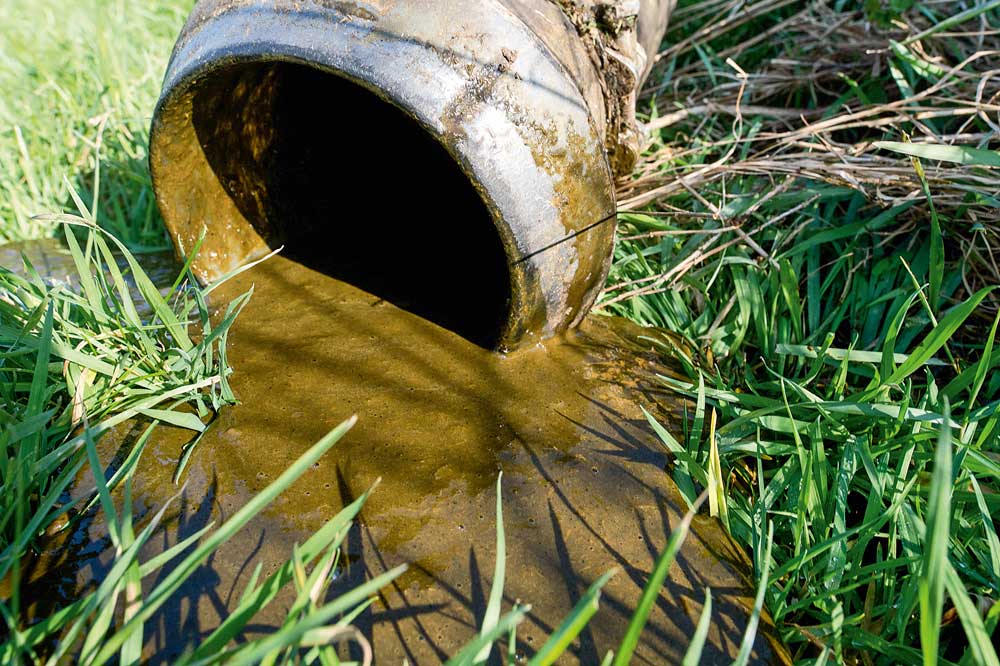Water pollution: Who’s to blame?
By Prof Tobias Licha, Göttingen University
Levels of nitrate and plant protection chemicals in drinking water are too high and large numbers of bacteria can be found in waterways and lakes. Such announcements frequently push farmers into the dock, accused as polluters of the environment. In fact, such accusations occur more often now. But are they actually true? Does the identified nitrate and crop spray substances really come from agriculture? If we find spray chemicals in water right in the middle of a city, or bacteria in some lakes far from livestock production units, there is room for doubt. The good news: One can almost always prove where the polluting substances come from – and demonstrate that agriculture isn’t necessarily to blame. The less welcome news: Hardly anyone bothers to carry out the required (complicated) investigations, so that the blame mostly remains with the usual suspect: »agriculture«. |
Few nanograms of certain materials identifiable
The great variety of possible organic compounds (reckoned currently at around 100 000 compounds) in the natural circulation of water makes accurate assessment of water quality next to impossible. Even with great effort, coupled to high costs, only about 8% of all possible substances are able to be identified. Also, such tests are of a purely academic nature and currently not available commercially. But modern environment analysis enables selected materials present at around a few nanograms per litre (ng/l) to be reliably identified.
This ability represents a new field in research: environmental forensics. Medicinal substances, materials from cosmetic production, but pesticides too, permit conclusions to be drawn regarding respective sources and such organic compounds are therefore described as indicator substances. To get a good overview of water quality and possible factors of influence involved, such indicators must be able to be used to identify the most important contributing sources.
Accompanying substances betray the source of water pollution
If, in a body of water, for example, the sweetener acesulfame is identified, this certainly does not come from agriculture but instead usually from domestic household wastewater. This therefore is an indicator for communal wastewater being a source of contamination. The presence of readily degradable substances such as caffeine or paracetamol additionally indicates relatively fresh (< 1 week) untreated wastewater as contamination source. And, for instance, x-ray contrast media is used by only certain hospitals and medical practices. Herbicide presence can be regarded as indicator of not only an agricultural source but also allow conclusions as to type of farming involved.
On top of this, substances such as antibiotics, antiallergics and some herbicides that are not continually applied, give information on the time factor as well as locality of use. This procedure using trace substances can thus help in the definite identification of pollution sources necessary for proving liability where water quality has been altered, as required under the Federal Water Resources Act (Wasserhaushaltsgesetz).
Where does the nitrate come from?
An interesting application area for environmental forensics is, therefore, determining the source of nutrients such as nitrate and phosphate in water bodies and groundwater. As well as originating from fertiliser, it is possible that these come from (small) sewage treatment plants, wastewater leakages, water retention basins and other sources, all seldom investigated so far. Household wastewater is, contrary to fertiliser, associated with a series of organic trace materials such as caffeine, medicines and the like. These can, alongside their role in nitrate contamination of water – when additionally contaminated by pathogens - represent a health risk. Should mineral fertiliser be the source of the nitrate, this is then mainly associated with the presence of metabolites from plant protection chemicals. The presence of antibiotics from the veterinary medicine group of sulphonamides can help in calculating the proportion of nitrate originating from livestock manure. Investigations in Lower Saxony found that every fifth ground water sample contained such substances. A mass balance of these indicators helps assess individual causes and, in the most favourable cases, enables a factually based challenge to the general condemnation of farmers regarding water body contamination. Especially in regions with very difficult hydrogeological properties (e.g. karst and fissured ground water aquifers), this approach is very promising.
Degradation products from plant protection substances deliver information on water body contamination source
It is also often possible to deduce from this approach how long it takes nitrate to leach from soil into ground water. This then enables a decision on how long it takes until procedures to reduce nitrate levels (e.g. the Federal Fertiliser Ordinance) in the groundwater have an effect. Here too, determination of the pesticide spectrum or metabolites from plant protection substances is appropriate. Because the licencing and active ingredient combinations in pesticides continually change, the presence in groundwater can help conclusions on how long the water, and with that also the nitrate, needs before it appears in the groundwater.
Precise water analyses and, above all the analysis of indicator substances, allow very exact information on groundwater contamination sources. Often, but by a long chalk notw always, it’s the case that arable farming and livestock production are responsible for pollution through nitrate or plant protection substances in water. Communities or industrial/commercial developments also come in question as culprits. An investigation into the important indicator substances can nowadays cost up to 1000 € in commercial laboratories. This is a lot of cash. But such action can help to clear a farm under suspicion of pollution offences, and even sometimes lead to the farm being able to continue in business. With growing demand and increasingly faster analysis, the costs for the water sampling and testing will also drop markedly.
Plant protection substance also in facade paints
Following the banning of total herbicides such as Diuron, as roadside weedkiller, these substances have experienced a renaissance over the last 15 years as component in façade paints applied on housing to improve thermal energy efficiency. Contrary to agricultural application, use as paint component features applications carried out very evenly year-round with a wash-off rate of approx.0.5 kg per storey, year and hectare. This means, for a house with 15 x 10 m ground floor area and three floors, a wash-off rate of 12 and 15 g per year. In many towns separation of rain water and wastewater is carried out. Together with the rainwater this herbicide then lands untreated direct in the soil surface run-off water and in this way often back into the ground water.
Tracing harmful substances
Examples of parameters of soil surface run-off water quality include measured electrical conductivity and pH value, but also concentrations of so-called priority harmful substances such as nitrate. The quality of water in water bodies is assessed on such bases and, where necessary, preventative or corrective actions for water improvement undertaken. The estimates are so far based on individual sampling, either through spot samples on particular dates, which give no indication of the dynamics involved, or through time series measurements which, on the other hand, permit no conclusions on area aspect of the water quality. If, after such tests, a water body indicates an unacceptable ecological and chemical condition according to Federal Water Resources Act thresholds, then the authorities responsible should initiate procedures for the improvement of the water body quality. However, no legal regulations exist regarding the form such actions should take, or which actions promise the most sustainable success.
How can water quality be improved?
With regard to quality of water bodies since introduction of the Federal Water Resources Act, this has not improved to any great extent. It is clear that the customary procedure shows great deficits. In order to better control surface water body catchment areas, sampling should take place:
- in markedly more locations,
- much more often,
- and with a greater range of substances tested for.





